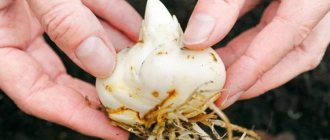Gladioli - flowers beloved by many gardeners require attention. They need to be dug up in time, trimmed, and then stored for gladioli storage in winter. There are many different options for storing gladioli in winter and we will tell you about all of them. We hope you will choose the most suitable method for yourself and save your favorite varieties of gladioli until spring.
To ensure that your gladioli delight you with abundant flowering and large corms, start cutting flowers according to the following scheme:
- Gladioli should be cut when the flowers are partially open.
- The best time to cut a gladiolus flower is when the bottom two flowers have bloomed.
- I cut the peduncles with a sharp knife early in the morning or in the evening so that the remainder of the peduncle is deeply hidden between the remaining leaves, of which there should be at least four on the plant, and which should ensure the further growth and development of the corm. After all, she needs to gain strength to please us with lush blooms next year.
The time when it is best to remove gladioli from the flower bed can be easily calculated. 30 - 50 days should pass after flowering, and then the gladioli can be safely dug up. The above-ground part of the plant should die off during this time, and only then can the gladioli be dug up and trimmed.
After digging, the gladioli are trimmed. And this must be done very carefully! Under no circumstances should you trim, tear off or twist the stems and leaves of gladioli until they die completely. Their death occurs exactly 30 - 50 days after flowering.
Why do you need to dig up gladioli for the winter?
Gladioli are heat-loving plants that can winter safely only at above-zero temperatures outside if they are first covered with covering material for the winter. Russia has a rather harsh climate, so the flower, which reproduces by bulbs, must be dug up for the winter.
When the outside temperature reaches +9°C, most plants go to sleep to begin a new growing cycle in the spring.
In addition to low temperatures, gladiolus is also threatened by other dangerous factors:
- infectious diseases;
- fungi;
- rot;
- pests;
- rodents.
Therefore, even in warm climates, there is a high risk that the plant will not overwinter in open ground. Knowing how to properly dig up and store gladioli in the fall, you can propagate expensive varietal material and successfully preserve it for later planting.
Do I need to dig up gladioli for the winter?
Galina Aleksandrovna Kizima
Well-known gardener-practitioner, candidate of technical sciences. He runs the “6 acres” column in the Kaleidoscope newspaper, gives lectures at the Gardener’s House and on Radio Maria, and is the author of many articles and books on gardening.
Gladiolus has a two-tiered root system. Tuber buds form on the mother bulb in its upper part. If a large bulb dies in winter from freezing or excess moisture in the soil, the tuber will go deep into the soil along with the root system and die due to lack of nutrients.
Choosing containers
Any container made of natural material is suitable for storage:
- cardboard box;
- fabric bag;
- paper bag;
- wooden box;
- mesh for vegetables.
Plastic and cellophane bags are not suitable because they do not allow the bulbs to “breathe”. You can wrap each one in newspaper to protect it from light.
To protect the tubers from insect pests, sprinkle them with powder, for example, Karbofos. You can also use the traditional method: put fresh garlic and dried mint leaves in a storage container. Check your inventory once a month.
Optimal timing for harvesting gladioli for the winter
All bulbous plants are dug out of the soil for the winter immediately after flowering. Before this you need to let them ripen. If this is not done, the bulb will not have time to accumulate nutrients that will help it survive the winter and then bloom profusely next summer. An unripe bulb may shoot without flower stalks or may not sprout at all after planting.
The surface part of the gladiolus will help you choose the right time. As soon as it completely turns yellow and dies, you can start working.
If you need to speed up the aging process of varieties that bloom in September, cut off the upper stems with flowers, leaving three at the bottom. The cut is made with a sharp knife at an angle of 45° and treated with potassium permanganate so that the gladiolus does not become infected with fungal and infectious diseases.
The timing should be based on the type and variety. Early flowering varieties are dug up earlier. After them, late varieties are dug up in the fall.
Experts also recommend following the digging order, taking into account the colors of their buds. First, you need to remove varieties whose flowers have the following colors:
- black;
- burgundy red;
- purple;
- purple;
- blue.
These species suffer more than others from mold, mildew and infectious diseases. To propagate rare varieties, it is imperative to leave shoots with flowers to allow the seed to ripen well.
Flowers grown from children are dug up last so that they have time to grow to normal size.
Disease Prevention
If defects are identified during the next inspection, measures should be taken immediately to eliminate them. Once they spread, they will lead to damage to all planting material. Problems may include:
- Formation of gray mold spots. It occurs when there is too much humidity and can be eliminated by wiping the bulbs and replacing the wrapping paper.
- The appearance of thrips. It is necessary to immediately remove the source of the spread of the disease and treat the remaining material with special preparations.
Another way to get rid of harmful insects is to treat damaged bulbs with medical alcohol. To do this, put the tubers in an airtight container and cover them with cotton wool soaked in alcohol. The container is hermetically sealed and after a while the thrips die. All that remains is to dry the bulbs. The procedure should be repeated after 4 days.
These rules for storing gladioli tubers should be studied before you start growing flowers. Only in this case will the garden be filled with beautiful plants until late autumn.
How to properly dig up gladioli bulbs
Flower growers should know how to properly dig up gladioli in the fall and then store them all winter. First, remove the tying material. Then they dig up the bulbs. Garden tools should be inserted vertically into the ground at a distance of 7-10 cm from the stem so as not to damage the roots.
The earthen ball is lifted on a shovel, after which the gladiolus is pulled out of the ground by hand by the stem and placed on a prepared area. All the children gather from the hole so that the soil does not become clogged in the spring.
The stems are cut off or broken off immediately. The soil is removed from the bulbs. If necessary, they can be washed and then dried in an open place. The main onion is separated by cutting off its roots completely. Only intact specimens should be stored without damage. Plants can only be dug up in dry weather.
We cut it correctly
The bulbs are trimmed, leaving a small “tail” of about 1 cm, and carefully cleaned of the children. The old corm is separated from the new one using a garden pruning knife. You cannot tear them off with your hands! If the children are difficult to separate, you can wait 2 weeks.
It is not recommended to peel the husks from gladioli: it is best to do this in the spring, before planting. It is then that it will be clear whether the onion is suitable for use or whether it is unhealthy.
What to do with the kids? Select large specimens, wash them and disinfect them. Until spring they should be stored at a temperature of -8–10°C. “Children” that have floated to the surface of the water cannot be planted.
Preparation and processing of corms
Having studied the rules of digging and specified the time, you will need to carefully study the methods of processing the bulbs. When to dig up gladioli after flowering in the open ground at a dacha in the fall in the Middle Zone or in another Russian region, how to process them and how to properly store them in winter - all this is important for preserving gladioli until next spring.
We dry it properly
If you live in the southern region, where it is warm even at night, after processing the bulbs can be left to dry directly on the street. A couple of days are enough for the tubers to dry in the sun. In other cases, gladioli should be dried in the house: the air temperature should be from 20 to 25 ° C.
Why do you need to dry planting material? This is necessary so that the tubers do not rot in the future. After a month and a half, you can check the bulbs again, separate the bottoms and roots, if you have not done this before. After pruning, it will become clear which specimens are sick and not suitable for planting: usually these are wet tubers with spots. They need to be thrown away.
Methods for storing gladioli bulbs
In order to get beautiful gladioli next year, you need not only to know when to dig up the bulbs in the fall and how to store them in the winter, but what place to store them.
First, the planting material needs to be kept for a month in a warm room, where the temperature is kept at 20-25°C, regularly checking it for integrity. Specimens with rot and deformation are rejected, after which only the whole material is sent for winter storage, having selected the optimal option for wintering gladioli.
You can store it in different places where the following conditions are met:
- air temperature from +3 to +8°С;
- humidity no more than 65-70%;
- lack of light.
Different places may meet these conditions, so the gardener will always choose the most suitable option for winter storage of gladioli.
In the apartment or on the balcony
City residents can store bulbs in their apartment between balcony doors or window openings, placing them in cardboard boxes. The ideal option would be an insulated loggia with a cabinet on which you can control the air temperature.
If there is a strong drop in temperature, bring the bulbs into the room or additionally cover the boxes, protecting them from freezing. You can store planting material in a foam or cardboard box with small holes for ventilation.
In the cellar or basement
Owners of a country house can store seeding material in the basement or cellar along with vegetables. The box should be placed in a remote corner so that it does not absorb moisture. For storage, wooden boxes with sand are used, which are installed on racks.
In the trench
In the south, gladioli can be stored in prepared trenches 80 cm deep and 70 cm wide. The bulbs are laid out in wooden boxes, covered with sawdust and installed in the trenches.
A layer of straw or dry leaves is placed on top, and then covering material. Laying in trenches should be carried out in warm weather, when frost has not yet set in.
In a refrigerator
If there are few flowers on the site, you can store them in a regular refrigerator, in the vegetable compartment, wrapping each bulb in several layers of paper. At the end of winter, the bulbs need to be taken out, dried in a dark, warm place and wrapped again in paper, placing them on a shelf with a lower temperature.
In bags
Most often, bags made of natural fabric are used as packaging. As a rule, garlic or mothballs are placed in them to protect against pests.
This packaging allows air to pass through well and protects from light. If there is a shortage of space, they are hung in a dark, cool room.
In a warm attic
If you have a country house with an insulated attic, you can store gladioli in boxes there, placing them closer to the pipe. Each bulb must be wrapped in paper so that the moisture does not erode from them, sorting them according to variety.
In the pantry
In such a place you can hang the bulbs in bags or in old nylon tights under the ceiling. It is important that the room temperature is kept at +7...+10°C.
In the ash or in the river sand
To maintain an optimal microclimate, the bulbs can be stored in wood ash or river sand, which is pre-calcined in the oven. It is important that they remain dry throughout the winter.
The bulbs prepared for winter storage are covered with ash or sand so that they are completely covered.
Pest protection
Every caring gardener should be able to properly store gladioli bulbs in an apartment in winter and know what is needed for this. An important step in storing such flowers is protection from all kinds of pests. Among them are thrips. To avoid damage to the crop by such dangerous creatures, the bulbs need to be treated with the drug “Inta-vir”. After this, they need to be dried again.
As an effective protective drug, you can use ready-made store-bought or homemade products based on the following ingredients :
- 200 ml water;
- 1 head of garlic.
The garlic cloves must be thoroughly chopped and then transferred to water. After 20-30 minutes of infusion, the bulbs are treated with the prepared solution. Then the tubers are removed from the liquid, and after final drying they are removed for further storage.
There are other equally effective ways to protect gladioli seed from various pests. For example, they can be treated with candle paraffin , which is preheated and used to treat the bulb. Once the substance has hardened, the tubers are moved to storage boxes. This method prevents the early development of tubers - they will not begin to grow before the set time.
In paraffin
An unusual way to store gladioli for planting is waxing. They use it for large bulbs; paraffin will not benefit children.
Paraffinization algorithm:
- Prepare 3 white paraffin candles.
- Boil water and arrange a water bath.
- Break the candles and put them in a container.
- Place the container in a water bath.
- Dip the bulbs into melted paraffin.
A neighbor in the country deliberately brings toads and frogs to the site: why and is it worth doing the same?
The processed gladioli are carefully placed on paper or fabric. Store in a dry, warm place. Paraffin protects from the external environment, prevents rotting and softening of the bulbs.
conclusions
To preserve roses, gladioli corms and dahlia tubers, you need to remember simple rules:
- do not store dahlias and gladioli together;
- provide the plants with the necessary temperature conditions and the required humidity;
- regularly check and discard spoiled planting material.
If these conditions are met, the “loss” will be small, and the gardener will be able to preserve the valuable plant until spring.
On FORUMHOUSE you can find more information: about storing gladioli, about storing dahlias in winter, read an article on how to make an excellent bouquet of country flowers. Watch a video that will teach you how to successfully store seedlings before planting.
Subscribe to our Telegram channelExclusive posts every week











